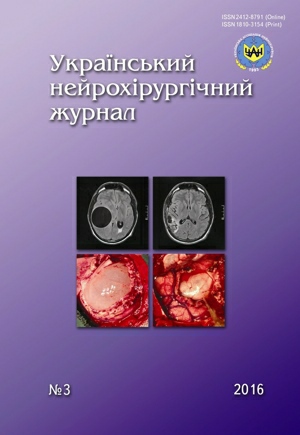Management of professional and specialized medical treatment in gunshot wounds of calvaria soft tissues
DOI:
https://doi.org/10.25305/unj.78779Keywords:
gunshot wound of head soft tissues, mine and explosive injury, risk development of intracranial complications, surgical treatment of wound, neurovisualizationAbstract
Research objective. To analyze aspects of gunshot wounds of head soft tissues, their combination to brain injury and on this basis to develop tactics and the principles of assistance at different stages of medical care in compliance of the military medical doctrine.
Materials and methods. On the basis analysis of 1214 combat injuries of neurosurgical profile gunshot wounds were in 434 (35.6%). Wounds of calvaria head soft tissues are diagnosed at 241 (55.4%), in 193 (44.6%) there were nonpenetrating and penetrating wounds with injury of brain. From 241 wounded 141 (58.5%) have finished treatment in the military medical hospital (MMH) (the second level of medical care) and in 100 (41.5%) wounded who had concussion, contusion of the brain and/or getting traumatic brain injury (TBI) were treated in neurosurgical departments.
Results and Conclusions. It is revealed that in 141 (58.5%) gunshot wounds of head soft tissues are not followed with brain injury. These wounded are in group of the low risk development of intracranial complications (RDIC) and have finished treatment at the second level of medical care in the MMH. In 100 (41.5%) of wounded soft tissues were followed by symptoms of brain injury (concussion, contusion, hemorrhage). These patients had average and high RDIC, and have been evacuated on the 3rd level of medical care and have finished treatment in specialized neurosurgical departments (the 3 and 4 levels). Gunshot wounds of head soft tissues without neurologic symptomatology can be treated at stage of the qualified medical care - the 2nd level - in field hospitals. Gunshot wounds of head soft tissues (41.5%) are followed often by traumatizing brain with average and high risk development of intracranial complications and this group of patients is evacuated on the third level of medical care in specialized neurosurgical departments.
References
1. Zarutsky YL, Shudrak AA, editors. Vkazivku z voenno-pol’ovoi hirurgii. [Instructions for military field surgery]. Kyiv: SPD Chalchynska NV; 2014. Ukrainian.
2. Danchin AG, Polischuk NE, Danchin GA, Melnick NF, Lurin IA, Danchin AA, Goncharuk ON, Krasilnikoff RG, Bibichenko SI. [Algorithm and medical care treatment for patients with gunshot rbain injuries during the military today conflict]. Ukrainian Journal of Minimally Invasive and Endoscopic Surgery. 2015;19(1):15-23.
3. Lebedev VV, Krylov VV, editors. Oruzheinue cherepno-mozgovie raneniya mirnogo vremeni: rukovodstvo dly vrachei. [Gunshot cranio-brain wounds of peaceful time: guidance for doctors]. Moscow: Medicine; 2001. Russian.
4. Chaplyk V, Oliynyk P, Tsehelskyi A, editors. Nevidkladna viys’kova hirurgiya. [Military Emergency Surgery]. Kyiv: Nash Format; 2015. Ukrainian.
5. Tsymbalyuk VI, Mogyla VV, Semkyn KV, Kurteev SV. Oruzheino-vzruvnue raneniya nervnoy sistemu. [Gunshot explosive wounds of nervous system]. Simferopol: KGMU; 2008. Russian.
6. Pedachenko EG, Danchyn OG, Polishchuk ME, V. Tsymbaliuk VI. Organizaciya nadanny specializovanoy neyrohirurgichnoy doponogi u viys’kovuy chas. [The organization of specialized neurosurgical care in wartime. Guidance]. Kyiv; 2014. Ukrainian.
7. Polishchuk NE, Starcha VI. Ognestrel’nye raneniya golovu. [Gunshot wounds of the head]. Kyiv: Publ. House Ltd. «TON»; 1996. Russian.
8. Sirko AG. [Gunshot wounds of the skull and brain during the armed conflict in eastern Ukraine. Message 2. Surgery treatment]. Ukrainian Neurosurgical Journal. 2015;(2)46-53. [Abstract/Full Text]
Downloads
Published
How to Cite
Issue
Section
License
Copyright (c) 2016 Andriy Danchin, Mykola Polishchuk, George Danchin, Oksana Goncharuk, Yuri Perekopayko

This work is licensed under a Creative Commons Attribution 4.0 International License.
Ukrainian Neurosurgical Journal abides by the CREATIVE COMMONS copyright rights and permissions for open access journals.
Authors, who are published in this Journal, agree to the following conditions:
1. The authors reserve the right to authorship of the work and pass the first publication right of this work to the Journal under the terms of Creative Commons Attribution License, which allows others to freely distribute the published research with the obligatory reference to the authors of the original work and the first publication of the work in this Journal.
2. The authors have the right to conclude separate supplement agreements that relate to non-exclusive work distribution in the form of which it has been published by the Journal (for example, to upload the work to the online storage of the Journal or publish it as part of a monograph), provided that the reference to the first publication of the work in this Journal is included.









